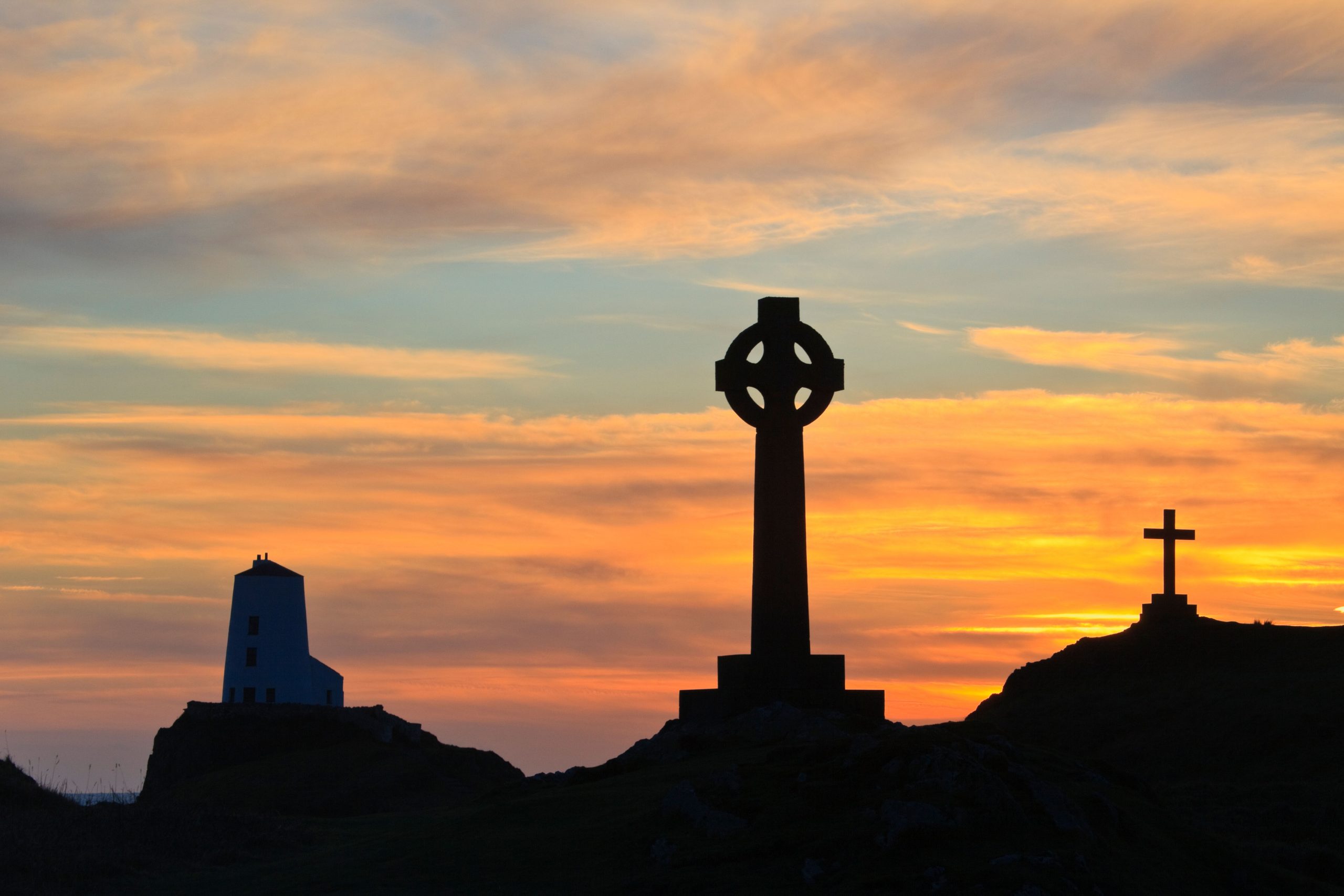Curious Question: Was St Valentine beaten to it by 1,000 years by the Welsh patron saint of love?
The arrival of St Dwynwen's day on January 25th prompts Martin Fone to recall the tale of a saint whose connection with romance and love predates St Valentine's by centuries.


Was Lord Byron anticipating Valentine’s Day 2021 when he wrote ‘love will find its way through paths where wolves would fear to prey’ (The Giaour, 1813)? In circumstances that would test the ingenuity of even the most determined of romantics, Britons still managed to spend £926 million in declaring their love to their chosen partners or demonstrating their romantic aspirations. The commercialisation of a day so important to the hospitality, gift, and greeting card sectors knows no bounds.
St Valentine, though, is not the only saint to be associated with the fortunes of love and even then, he is rather a latecomer to the party. The earliest reference linking the saint with love is to be found in Geoffrey Chaucer’s Parliament of Fowls. Valentine’s feast day, February 14th, was the day when all the birds gathered to choose their mates, he wrote. It was not until 1477 that Margery Bews called her fiancé, John Paston, her ‘right well-beloved valentine’, in a letter.
A saint who has a claim to rival St Valentine is one of the seven Archangels, Raphael, whose story is told in the Book of Tobit, included in the Apocrypha. Sarah was particularly unfortunate in love, having married seven times and on each occasion her husband had been killed on their wedding night by a jealous demon. Not surprisingly, Sarah was having trouble in attracting another husband and in her despair prayed to God, begging for a speedy end to her miserable life.
God, though, taking pity on Sarah, sent Raphael on a mission to find her another partner. Using all his charms he persuaded a young man by the name of Tobiah to marry her, giving him explicit instructions on how to drive the demon away. The couple married, and Sarah’s sceptical father prepared a grave to welcome the body of his eighth dead son-in-law. However, Tobiah followed Raphael’s instructions to the letter. The demon was driven off, the couple gave their thanks to God and enjoyed a night of connubial bliss.
Ever since, amongst the Catholic canon of saints, Raphael is the one who is properly associated with helping to forge partnerships, his success in finding love for the unfortunate Sarah amply proving the point. A spokesperson for the Catholic church noted in 2013 that while Valentine was the patron saint of those who have already found their soulmate, Raphael is the one to whom those seeking a partner should turn, a subtle nuance which may not have eluded canonical scholars but one which has been swept aside by the rush to commercialise Valentine’s Day.

What also held Raphael back was the absence of a feast day, an omission only rectified in 1921, when he was allocated October 24th in the General Roman Calendar. Following further calendrical revisions in 1969, Raphael’s feast day was moved to September 29th, a date he shared with fellow Archangels, Gabriel and Michael. To add to the confusion, a papal decree allowing a reversion to the General Roman Calendar of 1960 in certain circumstances has meant that Raphael’s feast day is still celebrated on October 24th in parts of the world. No wonder Raphael was swiped left in favour of Valentine.
Another woman unlucky in love was a princess from the 5th century AD, Dwynwen, the prettiest of King Brychan Brycheiniog’s twenty-four daughters — or perhaps his 36 daughters. The number varies depending upon the version of her tale you choose, though either way he was clearly well set for female offspring.
Exquisite houses, the beauty of Nature, and how to get the most from your life, straight to your inbox.
Dwynwen fell in love with Prince Maelon Dyfodril, but her romantic plans were thwarted as her father had promised her hand to someone else. To add to her woes, Dwynwen received a visit from an angel who brought her a sweet potion designed to erase all thoughts of Maelon and to turn the unfortunate beau into a block of ice.
In distress, Dwynwen fled into the woods and pleaded with God to help her forget all about Maelon. He granted her three wishes. Her first was that Maelon be thawed; her second that the hopes and dreams of all lovers were to be fulfilled; and, finally, that she would never marry. Her wishes were met and in an expression of gratitude, Dwynwen dedicated the rest of her life to the service of God.

The area around Newborough on the south-western corner of the Isle of Anglesey has something for everyone, including a forest, home to red squirrels and ravens, who appropriately mate for life, and a Warren which contains one of the largest areas of sand dunes in the UK. The headland offers spectacular panoramic views of the Llyn peninsula and the towering peaks of Snowdonia across the Menai Straits and the mountains of Wicklow over the Irish Sea, rain and mist permitting.
The jewel in the area’s crown, though, is the three and a half mile long sandy beach, awarded Blue Flag status in recognition of the cleanliness of the sea and its soft, fine sand, which leads to a tidal island. Perhaps more accurately, it should be described as a peninsula as only the highest of tides cuts it off from Anglesey. Accessible only on foot, Llanddwyn, meaning Church of St Dwynwen, was where Dwynwen chose to settle and found a nunnery, where, on her death in around 465 AD, she was buried.
Dwynwen’s story touched the hearts of many in Wales, and she became their patron saint of lovers. Her shrine on the island was a place of pilgrimage, visitors anxious to divine the faithfulness of their lover by visiting Dwynwen’s holy well, in which several eels lived. After sprinkling breadcrumbs into the well, an anxious woman would place a handkerchief on the surface. If the eels rose to the top of the well and disturbed the handkerchief, she could take it as a sign that her lover would be faithful.
So popular was it that Dwynwen’s shrine became the richest in the area, leading, in the 16th century, to the building of a substantial chapel on the site of her original chapel. The ruins of the structure can still be seen today. Nearby there is a Celtic cross, which was erected in Dwynwen’s memory in 1903, replacing an earlier simple cross from 1879.

The island nowadays is dominated by the tapered tower of Twr Mawr, a lighthouse which saw service between 1845 and 1975, one of two abandoned structures which bear testament to the treacherous nature of the waters nearby. There was a lifeboat stationed there from 1840 which within seven days in December 1852 rescued thirty-six sailors from three separate wrecks, and the cottages which remain were once used by pilots who guided ships through the Menai Straits.
January 25th, St Dwynwen’s feast day, is celebrated with the exchange of cards and other tokens of affection, offering the Welsh an early opportunity to say ‘Rwy’n dy garu di’, I love you. As their patron saint of love reputedly said, ‘nothing wins hearts like cheerfulness’.
I for one hope that this uniquely Welsh tradition continues to flourish and that Raphael makes a comeback. Why should St Valentine hog all the limelight? Dydd Santes Dwynwen Hapus to you all.

The true story of St Valentine, his legend and legacy of love
Whatever the truth of the real St Valentine, the middle of February has been a favourite time for lovers since

The true rose of St Valentine isn't actually red
In 1971 a Catalan rose-breeder called Pere Dot introduced a little pink Polyantha rose called San Valentin. Charles Quest-Ritson explores.
After graduating in Classics from Trinity College Cambridge and a 38 year career in the financial services sector in the City of London, Martin Fone started blogging and writing on a freelance basis as he slipped into retirement. He has developed a fearless passion for investigating the quirks and oddities of life and discovering the answers to questions most of us never even think to ask. A voracious reader, a keen but distinctly amateur gardener, and a gin enthusiast, Martin lives with his wife in Surrey. He has written five books, the latest of which is More Curious Questions.
